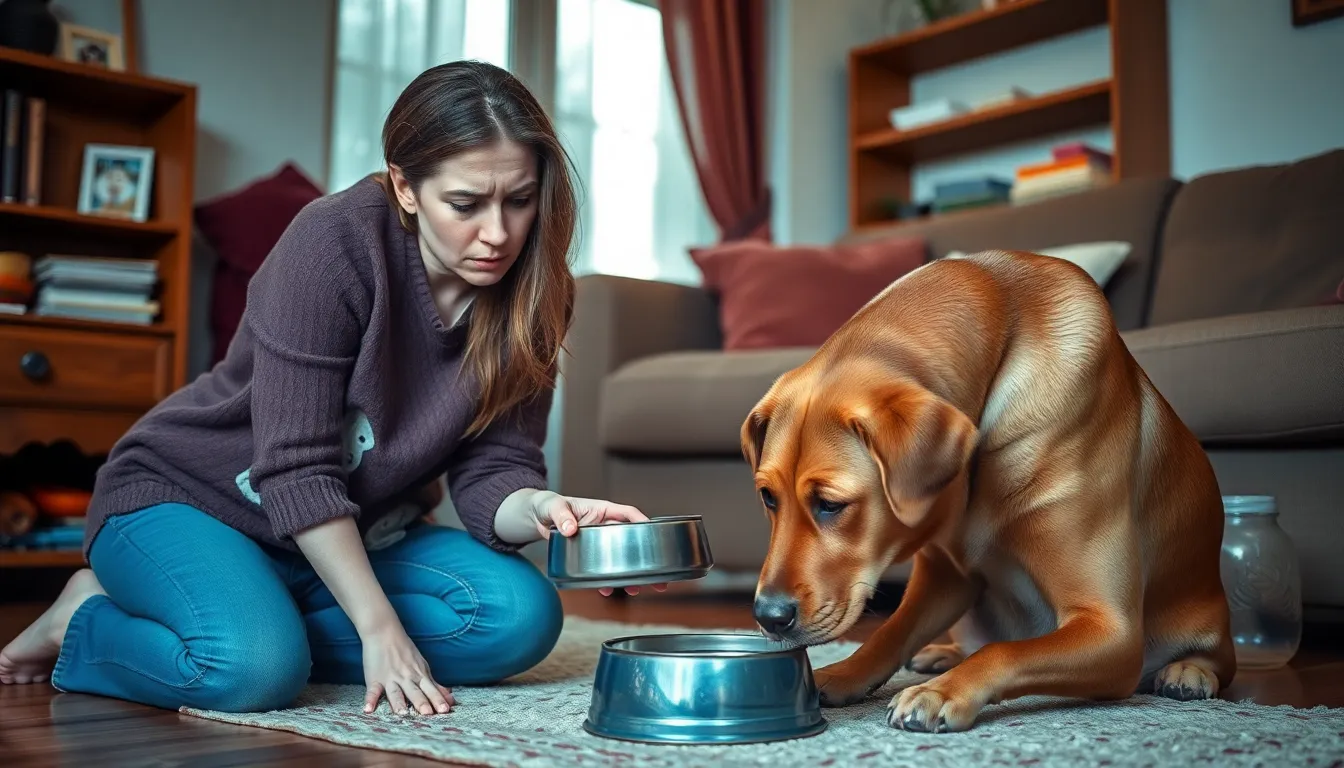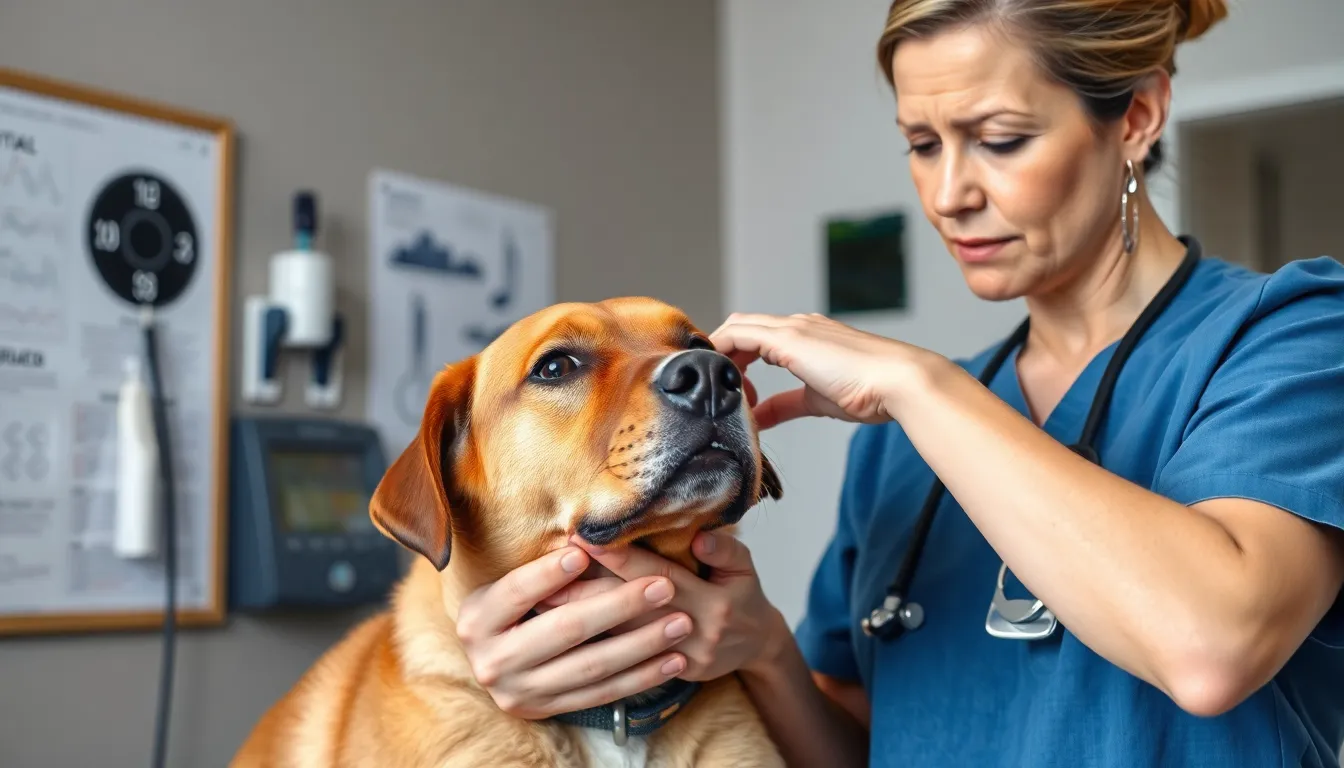When a dog stops drinking water but continues to pee, it raises immediate concerns for pet owners. This puzzling behavior can signal underlying health issues that require attention. Understanding the reasons behind this phenomenon is crucial for ensuring a dog’s well-being.
Dehydration can lead to serious complications, and recognizing the signs early can make a significant difference. Factors such as illness, stress, or dietary changes may contribute to a dog’s reluctance to drink. By exploring these aspects, owners can take proactive steps to address their furry friend’s needs and maintain their health.
Table of Contents
ToggleUnderstanding the Issue
Recognizing the reasons behind a dog not drinking water while still urinating is crucial for ensuring their health. Several factors may contribute to this behavior, leading to potential health concerns that pet owners must address.
Common Reasons for Low Water Intake
- Illness: Conditions such as kidney disease, diabetes, or infections can decrease a dog’s thirst. Each of these illnesses alters bodily functions, leading to lower water consumption.
- Stress: Environmental changes, loud noises, or trauma can cause stress in dogs, impacting their drinking habits. Stress might manifest physically, leading to reduced water intake.
- Dietary Changes: Transitioning to dry food from wet food can affect a dog’s hydration. Wet food contains water and often encourages higher fluid intake.
- Medications: Some medications can act as diuretics, increasing urine output and affecting thirst levels. It’s important to monitor water intake during medication changes.
- Temperature: Extreme heat can lead to reduced water intake. Dogs may not drink as much when temperatures are high, even if they require hydration.
Signs of Dehydration in Dogs
- Dry Gums: Healthy gums appear moist. Dry or sticky gums indicate dehydration.
- Lethargy: A lethargic dog may show decreased energy levels and reduced interest in activities.
- Loss of Skin Elasticity: When skin loses elasticity, it indicates dehydration. Pinch the skin on the back; if it doesn’t quickly return, dehydration may be present.
- Excessive Panting: Panting is common in dogs, but excessive panting can signal overheating or dehydration. It’s crucial to monitor this behavior closely.
- Decreased Urination: If a dog continues to pee but drinks little water, the volume of urine might decrease over time, leading to concentrated urine.
Each of these signs should prompt immediate attention, ensuring dogs receive proper hydration and care.
Health Concerns to Consider

Monitoring a dog that stops drinking water but continues to urinate raises significant health concerns. Identifying underlying medical conditions and evaluating the impact of medications is vital for maintaining a dog’s well-being.
Underlying Medical Conditions
Underlying medical conditions may cause a dog to drink less water while still urinating. Common conditions include:
- Kidney Disease: Reduced kidney function can lead to increased urination and decreased thirst. Sporadic water intake may exacerbate dehydration.
- Diabetes Mellitus: Diabetes results in elevated blood sugar levels, causing excessive urination and potential dehydration. Dogs may not drink enough to compensate for fluid loss.
- Cushing’s Disease: Cushing’s leads to hormonal imbalances, increasing thirst and urination. Some dogs may exhibit a decreased desire to drink.
- Urinary Tract Infections: Infections can alter urination frequency, leading to deviations in water intake and fluid loss.
- Gastrointestinal Issues: Conditions like vomiting or diarrhea can cause dehydration, influencing dogs to instinctively limit their water intake.
Immediate veterinary attention is necessary if any of these conditions are suspected.
Impact of Medications on Water Intake
Medications can significantly affect a dog’s water consumption. Certain drugs may contribute to dehydration or alter thirst, including:
- Diuretics: Medications that promote urination often lead to increased fluid loss and decreased drinking.
- Steroids: While steroids can increase thirst, they may also cause fluctuations in drinking behavior, leading to dry mouth.
- Antibiotics: Some antibiotics may lead to gastrointestinal upset, causing reduced water intake.
- Pain Relievers: Pain medications can impact a dog’s overall comfort, potentially affecting their desire to drink.
Assessing medication effects on water intake is crucial. Any changes in behavior warrant consultation with a veterinarian to ensure that the dog receives appropriate care and adjustments to its treatment plan.
Monitoring Your Dog’s Behavior
Monitoring a dog’s behavior is vital for identifying potential health issues, particularly when a dog stops drinking water but continues to urinate. Observing urination patterns and assessing overall well-being can offer critical insights.
Observing Urination Patterns
Tracking urination frequency and quantity helps discern possible health concerns. Pets may urinate more frequently under certain conditions or exhibit changes in volume. Signs to consider include:
- Increased Frequency: Urination more often than usual may indicate a urinary tract infection or diabetes.
- Urine Amount: Producing large volumes of urine could signal excessive drinking or underlying health issues such as kidney disease.
- Difficulty Urinating: Straining or discomfort during urination can signal serious problems like urinary blockages or infections.
Recording these behaviors can assist veterinarians in diagnosing potential issues effectively.
Assessing Overall Well-Being
Evaluating a dog’s overall health encompasses monitoring behavior, appetite, and energy levels. Key aspects to assess include:
- Appetite Changes: A marked decrease in food intake may correlate with dehydration or illness.
- Energy Levels: Lethargy or decreased activity can indicate medical conditions affecting hydration.
- Physical Signs: Check for symptoms such as dry mouth, sunken eyes, or abnormal body temperature, which may highlight dehydration.
Regular assessment can lead to timely intervention and better health outcomes for the dog.
Solutions and Remedies
Addressing a dog’s refusal to drink water while still urinating requires specific strategies focused on encouraging hydration and determining when to seek veterinary assistance.
Encouraging Hydration
- Fresh Water: Ensure access to clean, fresh water at all times. Dogs often prefer water that is free from contaminants.
- Water Bowls: Use multiple bowls around the home to promote drinking. Different locations may encourage dogs to drink more often.
- Flavoring: Add flavor to water using low-sodium broth or pet-safe flavor enhancers. This can entice dogs to drink.
- Wet Food: Incorporate wet or canned food into the dog’s diet. These food options contain higher moisture content and help increase overall hydration.
- Ice Cubes: Offer ice cubes as a refreshing treat. Some dogs enjoy chewing on ice, which can also supplement their water intake.
- Syringe Feeding: For dogs resistant to drinking, use a syringe without a needle to administer small amounts of water directly into the mouth, if comfortable.
When to Seek Veterinary Help
- Signs of Dehydration: Consult a veterinarian if signs of dehydration are present, including dry gums, excessive lethargy, or noticeable loss of skin elasticity.
- Behavior Changes: Changes in behavior, such as decreased energy, reduced appetite, or unusual urination patterns, indicate potential health issues that require professional evaluation.
- Prolonged Water Refusal: If a dog refuses water for over 24 hours while urinating, it is critical to pursue veterinary care to identify any underlying medical conditions.
- Accompanying Symptoms: Seek immediate help if symptoms like vomiting, diarrhea, or blood in urine accompany refusal to drink, as these may indicate serious health concerns.
- Medication Monitoring: If medications are involved, discuss with a veterinarian the impact of these drugs on hydration and their potential need for adjustment.
Addressing a dog’s refusal to drink water while still urinating is crucial for maintaining their health. Recognizing the signs of dehydration and understanding the underlying causes can lead to timely interventions. Proactive measures such as monitoring behavior and adjusting dietary habits can encourage hydration.
If a dog exhibits these concerning behaviors it’s essential to consult a veterinarian for a thorough evaluation. Early detection of potential health issues can significantly improve outcomes and ensure the well-being of the dog. Staying vigilant and responsive to changes in drinking habits is key to keeping a furry friend healthy and happy.







